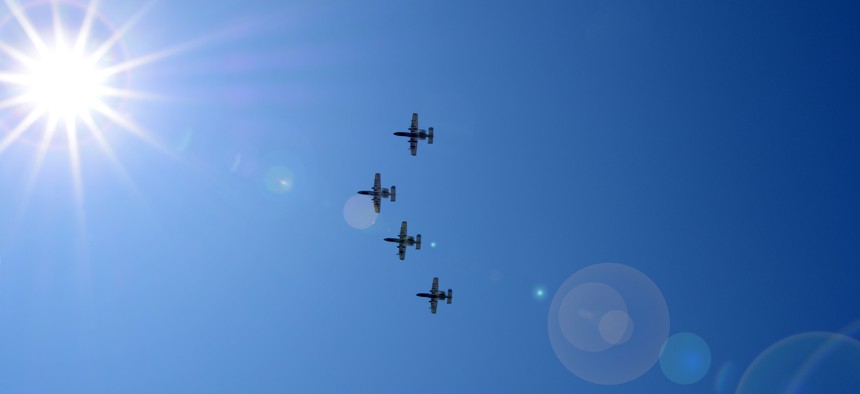
A-10s over Traverse City, Michigan. Deb Perry
R&D Tops Procurement in Air Force’s 2024 Budget Proposal
Meanwhile, the Space Force is requesting $30 billion in 2024, $3.7 billion above last year’s enacted budget.
The Air Force wants to scrap more than 300 aircraft and spend heavily on new technology so it can buy the higher-end aircraft and weapons that officials say are needed to keep up with China.
Overall, the Air Force proposes a $185.1 billion 2024 spending request, which is $5.4 billion higher than last year’s enacted budget. The service requested more money for research-and-development projects than for procurement of new weapons.
The budget request reflects the Air Force’s push towards next-generation capabilities, including its new Sentinel intercontinental ballistic missile, the B-21 Raider stealth bomber, and the Next Generation Air Dominance program, or NGAD—the service’s new, secret fighter jet.
“There's an emphasis on getting to the capabilities that we need to respond to the threat, which in many cases, some things we can do quickly. Other things are gonna take a lot of time,” Air Force Secretary Frank Kendall told reporters on Friday before the budget rollout.
Total R&D for the Air Force is $36.2 billion, $2.3 billion more than last year’s enacted budget. That includes $3.7 billion for the Sentinel program and nearly $3 billion for the recently unveiled bomber. Service officials said the budget procures “more than one” B-21.
The Air Force is asking Congress to greenlight a dozen new starts—including $500 million for a collaborative combat aircraft program which will develop drones to fly alongside manned fighters. Kendall said he wants CCA production to start before the end of the decade and reach operational capability in a “comparable” timeline with the NGAD program, which receives $1.9 billion out of the R&D budget.
To fund these new weapons, the service is asking to retire more than 300 aircraft in fiscal 2024, including 42 A-10 Warthogs, 57 F-15C and -D fighter jets, 37 HH-60G Pave Hawk helicopters, 24 KC-10 Extender tankers, 48 MQ-9 Reaper drones, and 52 T-1 trainers.
Most of the cuts are “continuations from existing authorities” the Air Force has already received, said Maj. Gen. Mike Greiner, the service’s deputy assistant secretary for budget. However, the service must re-request the approvals from lawmakers.
The Air Force is also asking for two divestments that were denied by Congress last year: to shed 32 Block 20 F-22 fighters and two E-3 Sentry AWACS-carrying radar planes.
Lawmakers added specific requirements in the 2023 National Defense Authorization Act before the Air Force could retire more E-3s, which Greiner said the service has met. These retirements would bring down the E-3 fleet to 16 aircraft.
When asked about a capability gap if the Air Force retires its E-3s before the E-7 Wedgetail arrives, Kendall said, “We’re not losing a lot by taking them out” since the sensor is “pretty ancient” and the aircraft are expensive to maintain.
Retiring some E-3s will free up parts to improve the readiness of the other aircraft it keeps, Kendall added.
“We looked hard at accelerating E-7 and we haven't found a way to do that in any meaningful way so far, ao it's a question of making the transition as smooth as possible,” the secretary said.
As it retires older aircraft, the Air Force wants to buy 95 aircraft and 72 fighters, including 48 F-35As. This is five more Joint Strike Fighters than was approved by Congress last year. Kendall said the service is sticking with its plan to buy a total of 1,763 F-35s.
“As you go over the five-year plan, we stay at that level [of 48 jets per year] basically for F-35s,” he added.
The Air Force is asking for 24 F-15EXs in 2024, but it will retire even more F-15Cs, which are reaching the end of their service lives. The F-35 will be the main replacement for its fighters, Kendall said.
“The F-15EX buy [is] a relatively small buy to replace part of the F-15 fleet. Going beyond that, we'd be looking at F-35s as the replacement for F-15s,” he said.
Other aircraft procurement includes 15 KC-46A tankers, seven MH-139 helicopters, and one E-11 communications plane.
For munitions, the Air Force will use authorities from last year’s NDAA to begin multi-year procurement efforts in 2024 and bring three of its missiles – JASSM-ER, AMRAAM and LRASM – into max production. There’s $1 billion in the budget request to put “money upfront,” sending a demand signal to industry, Greiner said.
Boosted Space Force
The Space Force is requesting $30 billion in 2024, $3.7 billion above last year’s enacted budget. About 65% of its total budget is going to R&D, Greiner said, including $1.1 billion for early missile warning and tracking to continue efforts to build a more resilient and proliferated missile tracking architecture.
Cost projections for the Space Force over the next five years are “reasonable,” Kendall said, but noted that there’s some “uncertainty about what follows the research and development” and how the service will realize its next-gen capabilities.
The department is procuring “hard kill and soft kill capabilities” for space in the budget request, Kendall said, but declined to speak on specifics due to classification.
In terms of procurement, this year’s budget is “all about launches,” Greiner said, requesting $2.6 billion to procure 15 launches between the Space Development Agency and National Security Space Launch.
The Space Force plans to add 800 guardians in 2024, moving 700 from the Air Force and 100 from the Army, Greiner said. The service currently has about 8,000 troops as it builds toward a final force of roughly double that.
NEXT STORY: The Pentagon’s 2024 Budget Proposal, In Short




